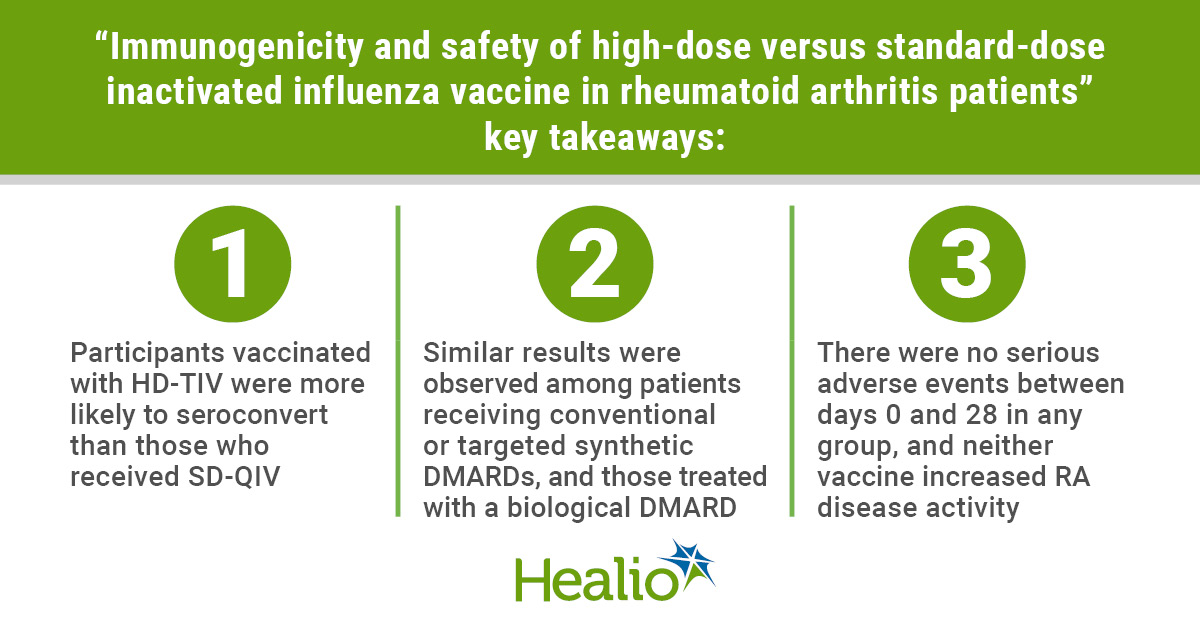High-dose trivalent flu vaccine safe, more immunogenic than standard dose in RA

Among patients with seropositive rheumatoid arthritis, high-dose trivalent inactivated influenza vaccines are safe and more immunogenic than the standard-dose quadrivalent version, according to findings published in The Lancet Rheumatology.
“In both older individuals and patients with rheumatoid arthritis, reduced vaccine-induced protective responses have been attributed to chronic inflammation, an increased frequency of comorbidities and polypharmacy,” Inés Colmegna, MD, of McGill University in Montreal, and colleagues wrote. “In other immunocompromised individuals (eg, solid organ transplant recipients, hematopoietic stem cell transplant recipients, and children or young adults with cancer or HIV infection), two influenza vaccines developed for older individuals (eg, MF-59 adjuvated vaccines and HD-TIV) have demonstrated greater immunogenicity compared with standard-dose vaccines.”
“To our knowledge, however, no studies have compared these formulations to a standard-dose vaccine in people living with chronic rheumatic diseases,” they added. “Because of the disproportionally high burden of influenza in patients with rheumatoid arthritis and their generally poor response to standard-dose vaccines, such studies are urgently needed.”
To evaluate the immunogenicity and safety of a high-dose trivalent inactivated influenza vaccine (HD-TIV), compared with a standard-dose quadrivalent influenza vaccine (SD-QIV), among patients with RA, Colmegna and colleagues conducted a treatment-stratified, randomized, double-blind trial. The researchers recruited 696 adults with RA who were positive for rheumatoid factor, anti-cyclic citrullinated peptide, or both, from three hospitals affiliated with McGill University during the 2016 to 2017 and 2017 to 2018 influenza seasons.

All participants had been treated for RA with conventional or targeted synthetic DMARDs, biological DMARDs, or a combination, and were still receiving treatment at the time of their enrollment. Treatments were not modified in the 3-month runup to enrollment.
Participants were assigned to one of three groups based on treatment. Those receiving conventional or targeted synthetic DMARDs, in combination or as monotherapy, were identified as group one. Those treated with a biological DMARD, with or without methotrexate, hydroxychloroquine and/or sulfasalazine, were group two. Lastly, those taking abatacept (Orencia, Bristol-Myers Squibb), tofacitinib (Xeljanz, Pfizer) or rituximab (Rituxan, Genentech), with or without methotrexate, hydroxychloroquine and/or sulfasalazine, were stratified into group three.
Of those recruited, 279 were randomly assigned to one of two groups, with 140 vaccinated with the SD-QIV and 139 receiving the HD-TIV. The primary outcome was the seroconversion rate, based on hemagglutination-inhibition assay, per strain at day 28. The researchers conducted their analysis using a modified intention-to-treat population, which was all randomized participants for whom seroconversion data were available. This included 136 patients vaccinated with SD-QIV and 138 who received HD-TIV.
According to the researchers, participants vaccinated with HD-TIV were more likely to seroconvert than those who received SD-QIV. ORs were 2.99 (95% CI, 1.46-6.11) for seroconversion to strain A/H3N2, 1.95 (95% CI, 1.19-3.22) for strain B/Bris and 3.21 (95% CI, 1.57-6.56) for strain A/H1N1, during the 2016 to 2017 influenza season. For the 2017to 2018 season, the OR was 2.44 (95% CI, 1.18-5.06) for seroconversion to strain A/H1N1.
Regarding RA treatment groups, similar results were observed among patients in groups 1 and 2. However, there were not enough participants in group 3 to draw any conclusions. Local and systemic adverse events were similar across both vaccine groups. In addition, there were no serious adverse events between days 0 and 28 in any group, and neither vaccine increased RA disease activity.
“This is the first [randomized controlled trial] comparing standard dose influenza vaccine with HD-TIV in patients with rheumatoid arthritis,” Colmegna and colleagues wrote. “It provides evidence of the immunogenicity and safety of the HD TIV in this population, enhancing our ability to provide informed vaccine recommendations for patients with rheumatoid arthritis and possibly for people living with other chronic inflammatory rheumatic diseases on similar background therapies.”
“These data are also relevant to inform policy to facilitate patients with rheumatoid arthritis to access HD-TIV,” they added. “Ultimately, such improved access would enable large-scale efficacy and effectiveness studies of HD-TIV in this vulnerable population.” – by Jason Laday
Disclosure: Colmegna reports no relevant financial disclosures. Researcher Brian J. Ward, MD, of the McGill University Health Center, reports personal fees from Medicago.
